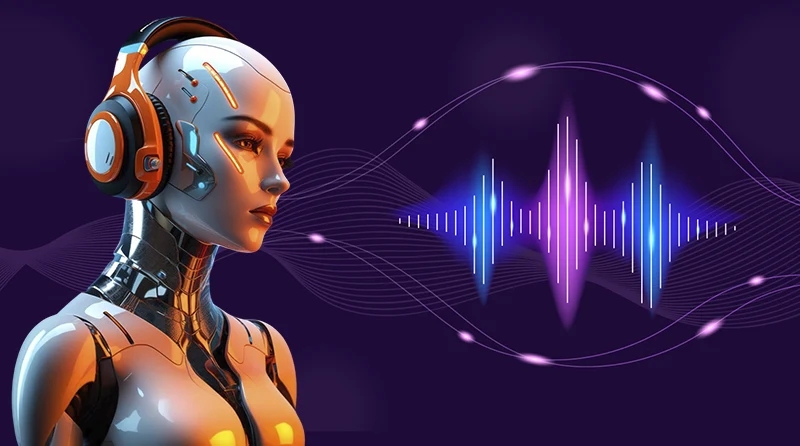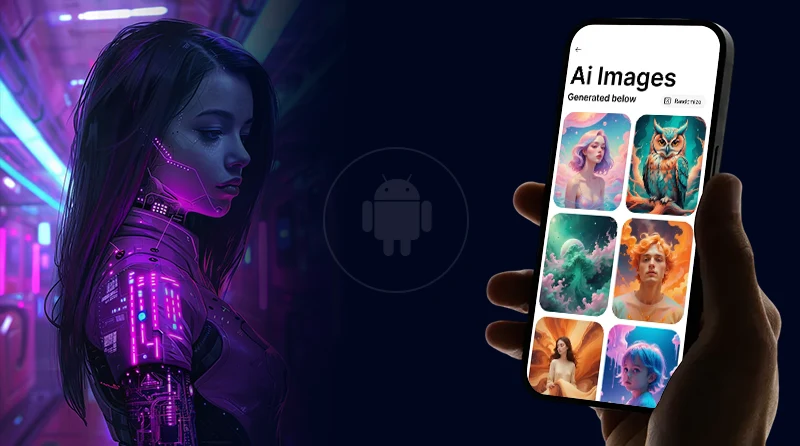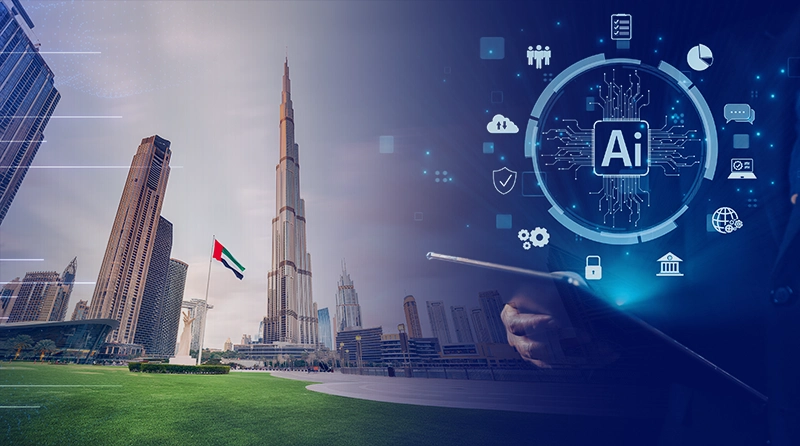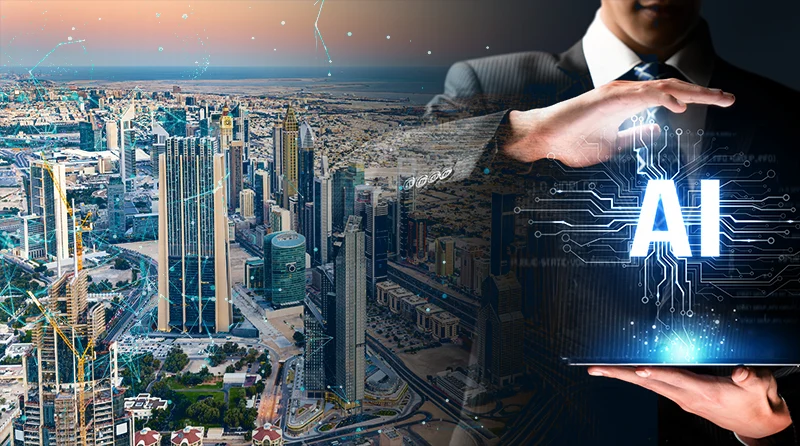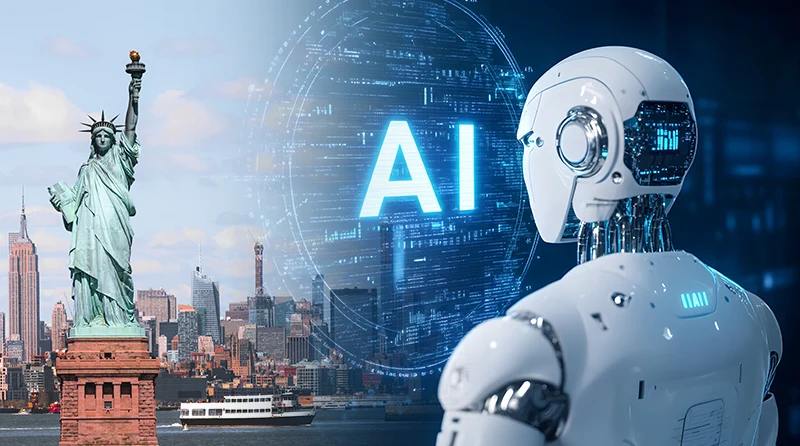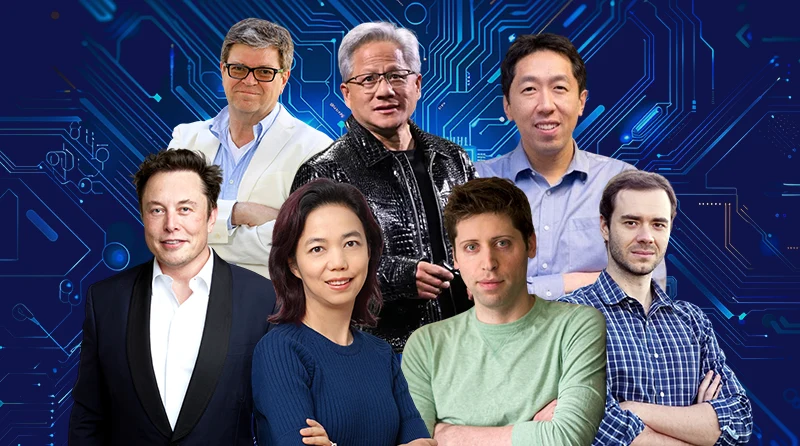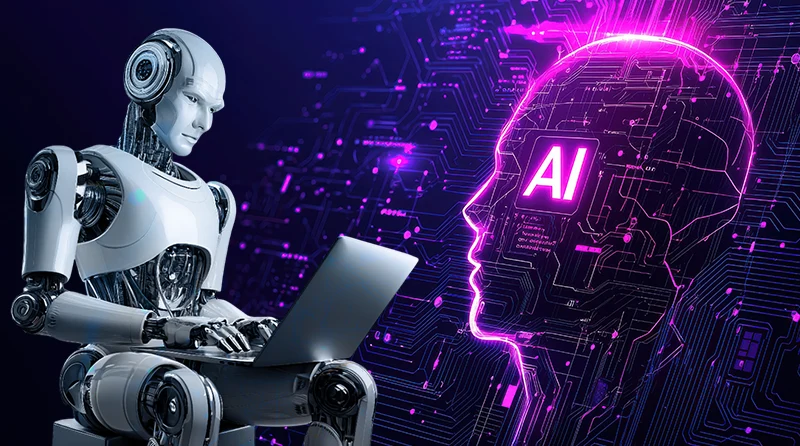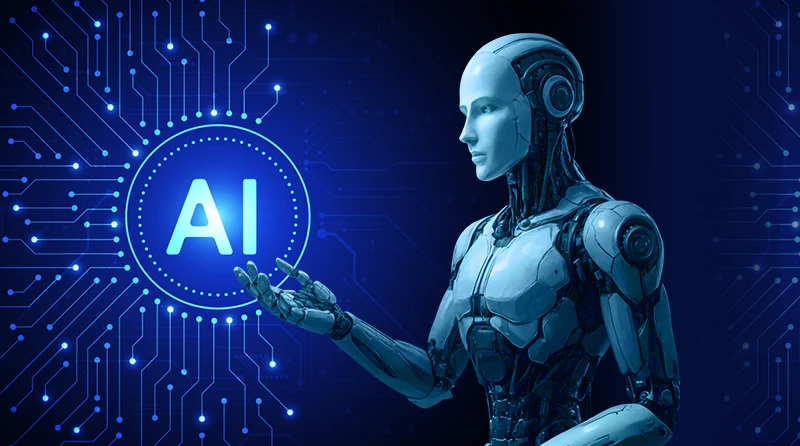Top 10 AI Use Cases in Education (2025 Guide)
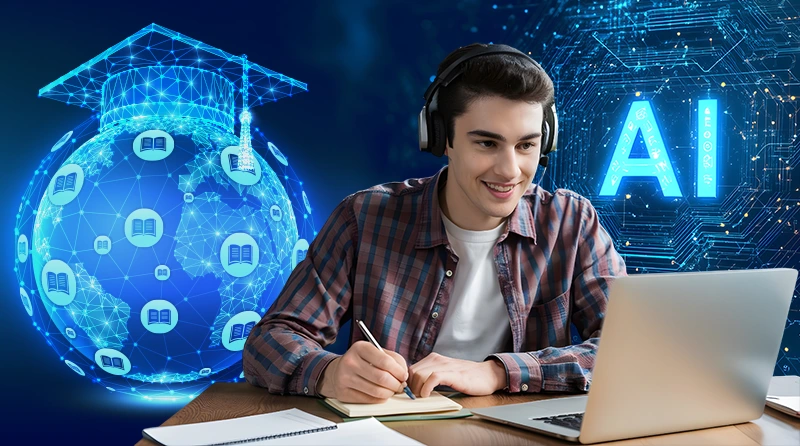
It’s not even a decade since we began witnessing the implementation of AI in our daily lives. Whether it is using ChatGPT to generate content or enterprises using smart chatbots to provide customer support, everything has transformed so rapidly that we never had time to appreciate this constructive change.
Today, just like every other industry, AI in education is also making headlines now and then. While some consider it a catalyst for better learning experiences, some heads never forget to criticize AI in higher education.
According to Grand View Research, global AI in education market size was estimated at $5.88 billion in 2024 which is increasing with a CAGR of 31.2%. It means the market will achieve a valuation of $29.9 billion by the end of 2030.
So, how are AI Use Cases in Education making the change, what are the use cases, what benefits are we talking about, and the biggest question, what is going to be the future of this transformation?
We’re going to talk about everything in this blog. So, if you are someone who loves to explore technical words or just a curious mind that likes to embrace new technology before it becomes common, you are at the right place.
Let’s get started
What is AI in Education?
The education industry is one of the niches that can not accept every other transformation just because it is directly linked to the future of the nation. However, artificial intelligence has proved to be a worthy implementation that can enhance the learning experience, foster a better learning approach, help learners identify their weaknesses and implement improvements, and much more. AI in education is simply a concept where educational institutions implement artificial intelligence technology to automate tasks and establish a better learning environment.
It can include the use of AR/VR to bring lectures to real-life, real-time performance monitoring tools that help to track the learner’s performance, identify critical areas, and curate an improvement strategy, a smart syllabus design software that manages the learning sessions according to individual learning pace, and much more. Many creative ideas have been implemented using AI that were never imagined just years ago.
The following table will provide you with a glance at the difference between the scenario of a traditional learning environment and an AI-enabled learning environment-
| Differentiating Factor | Traditional Learning Environment | AI-Enabled Learning Environment |
|---|---|---|
| Teaching Strategy | Common lecture classes for all learners, irrespective of their abilities | Personalized learning pace adjustment with adaptive AI software |
| Student Engagement | Often differs from student to student, and thus they have to look for passive learning | Interactive learning sessions with AR and VR experiences for better engagement |
| Tests and Assessments | Periodic quizzes, exams, and tests to check the learning | Online assessment and real-time identification of gaps to conduct improvement sessions |
| Learning Style | A uniform and non-personalized learning style for all the students | The learning pace is tailored for individual students according to their learning ability |
| Resource Availability | Students have to rely on in-class materials, textbooks, and offline libraries | Access to vast learning materials, including online libraries, interactive recorded sessions, and PDF notes |
| Feedback Process | Limited time for interacting with the tutor and no option for remote interaction with the teacher | Immediate feedback sessions with a focus on identifying issues and facilitating solutions |
| Data Utilization | No real-time data is collected about students to take insightful initiatives | A lot of data is collected about each student to take initiative for better learning |
| Core Focus | Just focuses on learning the pre-decided syllabus and memorization | Focuses more on skill development, critical thinking, and problem-solving abilities |
AI in Education Statistics
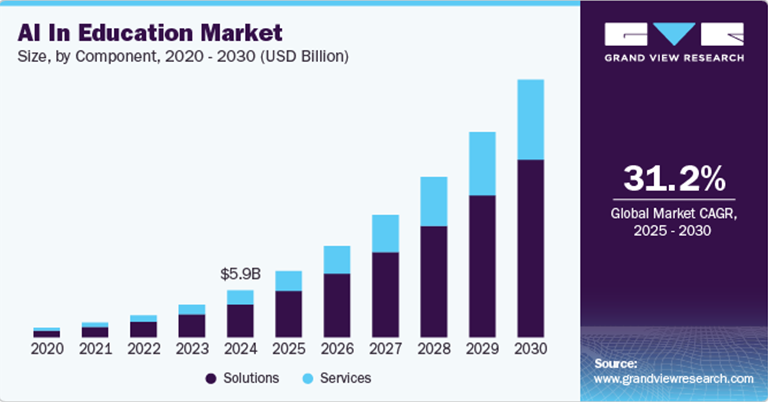
Before jumping to the use cases and benefits of AI use in education, let’s have a glimpses of what real time market stats say about using AI in the education system.
- As per a survey, 55% of the respondents told to Forbes that AI implementation has improved the educational outcomes for them.
- At the same time, it has also been reported that 60% of educators are already using artificial intelligence in their classrooms for different purposes.
- According to Harvard Graduate School of Education, 51% of young people in education are using generative AI at some point.
- From the 51%, 53% were using AI for getting information, while 51% were using AI applications in education for brainstorming.
- According to statistics, more than 33% of educators and professionals believe that it is very important for students to learn and experience AI in schools.
- Around 54% of the parents worldwide believe that AI will have a positive impact on their child’s education if implemented well.
- 53% of the post-graduates and 46% of the college graduates in the USA claim that AI is a part of their day-to-day life.
10 AI Use Cases in Education

While the AI use case in education depends on the creativity and thinking ability of learns and educators, there are some core use cases of artificial intelligence that we can witness in every educational institute. Here are the best use cases of artificial intelligence associated with the education industry.
1. Personalized Learning
Whenever we talk about AI in higher education, the first thing that is imagined is personalized learning. The reason is simple. We all have grown up using the traditional learning approach, and at some point in our learning journey, we all have felt the need for a personalized learning plan that can align with our requirements and interests. So, AI well tackles this need as it helps the educational institute to focus on the individual learning capability and deploy machine learning concepts to transform the way a student learns lessons and adapts them. It helps to foster customized learning programs, AI-embedded games, and much more.
2. Smart Tutoring System
Unlike the traditional learning methods, AI use in education has enabled the smart tutoring system that leverages advanced algorithms to provide real-time feedback and improvement assistance to learners. As soon as a learning assessment is carried out, the AI system analyzes the response, identifies the key areas of difficulty for the student, and facilitates a tailored explanation to make future improvements. At the same time, it also helps to foster an approach that can better align the learning pace of students.
3. Automated Grading System
The smart grading system is highly used by educational entities around the world, which helps to analyze student work and conduct unbiased evaluations. The automated software plays a significant role in lightening the educators’ burdens while allowing them to have more time for better and personalized guidance. The system is trained on the provided answers and responses, which can identify if the student has provided the right response. It can also dictate the marking and overall results with high efficiency and accuracy.
4. Curriculum Planning
Planning the complete schedule for teachers and resources available with the institute becomes extremely easy with artificial intelligence. Not only aligning the teacher’s availability to classesbut it also identifies the gaps and trends in the learning environment to suggest improvements and adjustments in the overall curriculum. Moreover, the educational centers can also set the goals and scope of the whole year so that generative AI in education can curate a tailored approach for both learners and teachers that can help achieve that goal with great efficiency.
5. Language Learning
The traditional language learning concept relied solely on the printed books, a teacher, and boring one-way learning sessions. However, the burgeoning role of AI in education has transformed the way students learns a new language. There are innovative apps and software like Duolingo that make language learning much easier and interesting to the learners by offering games, interactive sessions, and quick feedback and assessments. The features like text-to-speech, speech-to-text, and more enhance the overall experience of students.
6. Interactive and Learning Games
This is among the best uses of AI in education that makes learning a lot interesting for the students. Artificial intelligence turns the boring learning classes into highly interactive and fun games that attract the learners and don’t leave them exhausted at the end. Whether it is exploring a historic place through an adventurous game or just learning about the new technologies by making inventions in the game, there are endless creative game ideas that can transform the learning experience and steer the youth towards a more fun yet value-driven educational experience.
7. Smart Content Creation
Whether it is making notes of important topics or presenting a subject with in-depth insights, content creation is a crucial part of the education industry. However, thanks to artificial intelligence, this crucial task can now be performed much quickly and efficiently. Students can use the 2D-3D visualization techniques in their projects, which helps to better understand the subject. Similarly, the teachers can now leverage the digital lesson generation that helps to curate the handwritten notes of highlighted topics within minutes for students. At the same time, frequent content updates are also possible with AI applications in education that keep the learner ahead of the curve.
8. Self Learning with AI
Gone are the days when students used to utter the sentences while facing a wall to learn the topics. Using AI in education brings the self-directed learning concept to the field, which offers interactive agents to students. These interactive agents are designed to help the student know more about the topics, create notes, highlight the most important parts, take the assessment, and even play a quiz with the student. 24*7 availability of this tool provides flexibility to the learner.
9. AI Monitoring System
An AI-based monitoring system is used in prestigious educational institutions during exams and quizzes. These smart systems remain active throughout the examination period and alert the authorities as soon as any suspicious activity is recorded. It can include students trying to cheat, unnecessary conversation with classmates, using any electronic device, and much more. For the institutes that conduct examinations of thousands of students, this is a great use of AI in education.
10. Dyslexia Detection
According to the National Institute of Health, around 10% world’s population has Dyslexia, which makes it difficult for them to read and learn. So, AI has proven to be an effective and valuable solution that helps to detect Dyslexia among learners in the early stage. It analyzes the reading pattern of the students, and the sensors incorporated in the AI system help to identify the anomalies. The data is then processed further to determine the degree of Dyslexia. The quicker identification of such a situation allows the tutors and parents to take preventive and improvement measures.
7 Benefits of AI in education
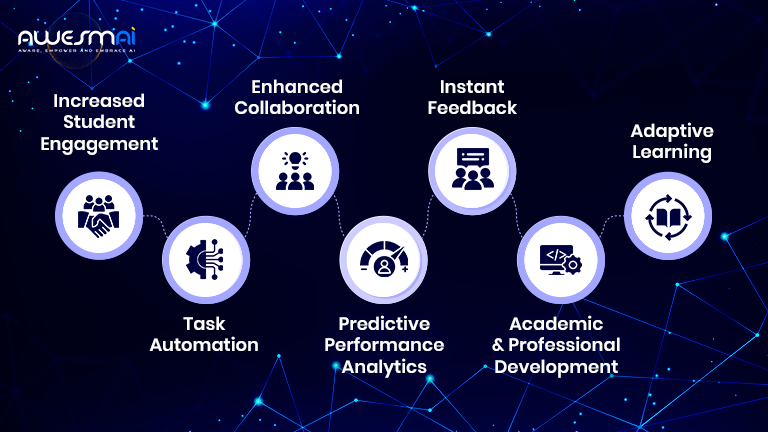
AI use cases in education bring along numerous benefits, which make the overall learning journey more insightful, engaging, interesting, and fun for the students. The integration of AI in higher education allows the learners to not only cram the information but also live it by experiencing the things in the environment. For example. AI can use augmented reality to create a visual representation of Jupiter in the classroom that helps the students to better learn about the surface and resources of that planet. Let’s explore many other benefits like these-
1. Increased Student Engagement
As soon as the innovative AI-driven solutions replace the boring lectures and textbooks, student engagement increases automatically. No doubt, reading the three laws of Newton might not bring that understanding that can be achieved by showcasing the real effect of those three laws. The interactive learning modules, real-time assessment, flexible learning timings, and many other features make the education engaging for the students.
2. Task Automation
Incorporating AI in education automates a range of tasks for both the institute administrations, tutors, and learners. Whether it is scheduling the classes, grading the test papers, designing the overall curriculum according to available resources, managing student enrollment, creating notes, or anything else, everything can be performed within minutes using the right AI applications in education.
3. Enhanced Collaboration
AI in higher education plays a significant role in fostering enhanced collaboration among the learners, tutors, and administration. From taking part in the group projects or working collaboratively on the assignment, AI brings the cloud solutions that offer real-time access to update and enable multiple students to work on the project irrespective of their location. At the same time, the live video calling and suggestions help to achieve better outcomes.
4. Predictive Performance Analytics
AI solutions are highly trained on the data. Thus, implementing AI in the education system will help enable the institutes to closely monitor the performance of a student from the first day to check if the learner will do good in the final examinations or not. So, it becomes easier for the tutors to identify the key weaknesses of a student and thus curate a customized learning plan that can help work on those weaknesses.
5. Instant Feedback
With AI in education, students don’t have to wait for the weekly feedback session to get the required assistance. Artificial intelligence allows the learners to submit their assessment, and the software can generate a personalized feedback report within minutes. At the same time, it also outlines the key areas of strength and weakness that help the student make the required changes in their learning schedule. The reliance on human counterparts reduces in the overall process, which encourages self-dependency among the students.
6. Academic and Professional Development
While the traditional learning process focuses solely on the academic development of the students, the same is not the case with artificial intelligence. Unlike the traditional approach, it plays a significant role in preparing the students for their professional journey. For example, it outlines the core concepts in academic learning that are most important in higher education and a further professional journey. Focusing more on such concepts brings the practical knowledge to the student that further contributes to the professional journey.
7. Adaptive Learning
This is one of the best AI use cases in education that helps students to learn according to their particular schedule and pace. Thus, it becomes easier for a learner to clear all the concepts and doubts of the existing topic before they move forward to another one. At the same time, AI software automatically fetches the student progress, that boost motivation for performing even better.
5 Key Challenges of Using AI in Education
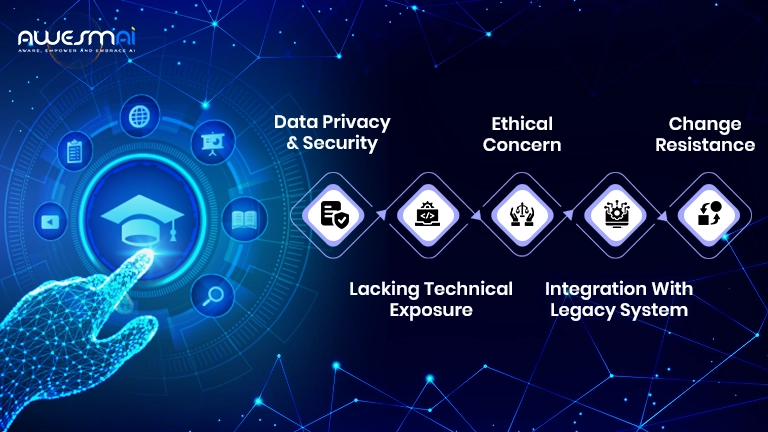
Just like any other industry, implementing AI in education has its pros and cons. So, it entirely depends on the institute and the learner if they can explore the advantages while overcoming the challenges and disadvantages. Let’s have a glance at some of the main key challenges of AI in education so that you can take the right approach-
1. Data Privacy and Security
As interpreted in the earlier section, an AI model requires access to a huge amount of data, which causes data privacy and security risks. Even in real life, a lot of incidents have been witnessed across industries where the centralization of data for the efficient use of AI has proved to be a wrong idea, as it made it easier for hackers to attack the source and get confidential information.
Solution
To make sure that all the data about learners, tutors, and the institute is safe while using AI, a lot of practices are ensured, which include data encryption, access control, and efficient adherence to data protection regulations like GDPR.
2. Lacking Technical Exposure
This is a prevalent challenge for educational institutions in developing areas where tutors and learners are still not exposed to technical solutions and digitization. The scenario makes it extremely challenging for them to efficiently implement artificial intelligence and leverage the benefits.
Solution
The ongoing training and assistance to administrative people and tutors about the use of AI in education is a great solution. At the same time, the AI development partner can provide consultation before implementation to ensure that the educational institute can harness the benefits of a particular AI system.
3. Ethical Concern
Irrespective of the industry or application, the use of artificial intelligence is always associated with a lot of ethical concerns. While some question at the integrity of AI tools, others have the doubts about the accuracy of outcomes generated by AI. However, there is no doubt in the truth that inefficient training of an AI model might generate a biased and incomplete output that further encourages the ethical concerns.
Solution
It is the responsibility of an AI development company to conduct regular audits to ensure that AI system is not generating biased results. At the same time, the high-quality data must be used to train the AI model so that it can produce accurate and insightful results while maintaining accuracy.
4. Integration With Legacy System
Most educational institutes have some sort of software that makes the day-to-day chores easier for them. Whether it is attendance tracking software, a quiz tool, or finance management software, the integration of AI into this legacy system is very important yet most complex task. The inability of an AI development partner to integrate AI in such a system might affect the operational process, efficiency, and ROI of the complete project.
Solution
The educational institute must ensure that it chooses the AI solution with interoperability standards. It makes it easier for the AI development company to integrate the solution into the existing technological infrastructure. Moreover, seeking post-maintenance and support is also a great idea to ensure seamless integration.
5. Change Resistance
This is a challenge that is mostly found among less-developed educational institutions. At the same time, the availability of limited resources makes it even difficult for them to adapt to the changes while maintaining the existing work speed. So, many educational entities are resistant to change and adopting artificial intelligence.
Solution
Offering training to less developed educational institutes can be a great strategy to help them seamlessly transform traditional teaching methods. At the same time, the implementation of pilot programs to demonstrate the effectiveness of AI solutions is also a great technique to encourage institutions to change.
Generative AI in Education
Generative AI is the most popular and widely used part of artificial intelligence. Thanks to the tools like ChatGPT, Gemini, Perplexity, and many more, which have opened up a huge target audience to the use of AI in their day-to-day life. Well, generative is not just limited to producing some words according to the given prompt; it is capable of performing tasks much more than that. Let’s explore how generative AI transforms the various processes in education-
| Task | Traditional Approach | Gen AI Advancements |
|---|---|---|
| Admission Process | It generally includes tasks like taking an interview, assessing eligibility criteria, monitoring the feedback, and then making the decision. | Generative AI automates the data collection process that helps to evaluate the eligibility and qualification of students for faster decision-making. It can analyze thousands of applications and interviews within seconds that saving hours and even days for big universities. |
| Student Enrollment | The student enrollment process includes tasks like collecting personal details of students, gathering academic details, and sending notifications for enrollment status. | Implementing generative AI applications in education helps to autofill the details of students using a smart recognition system. It also helps to cross-check the details by comparing data from different sources and automatically sends personalized notifications. |
| Curriculum Development | The traditional approach identifies the relevant materials for a particular course and relies on human experts to create the content for that course. At the same time, it hires reviewers to check the course and summarize the necessary revisions. | Generative AI fosters a smart approach that helps to design the curriculum based on learning objectives. At the same time, it compares the overall objectives with existing content to make the required changes. AI also helps to assign tasks to reviewer according to their expertise and generate reports on suggestions for improvements. |
| Student Record Management | Keeping records of every student in the institute consists of managing academic transcripts, recording attendance, ensuring data accuracy, authorizing access, recording data changes, tracking access history, notifying administrators, and much more. | Generative AI automates the transcripts with real-time information while maintaining the attendance records dynamically. Moreover, it manages access control based on defined roles, tracks all the data to update the access, and generates a real-time report on the student record access history. |
| Student Support | In a traditional arrangement, providing student support involves assigning a query to a counselor, assessing the urgency of the inquiry, verifying student details, cross-checking the records, retrieving student performance information, assessing academic and sports performance, and much more. | Generative AI applications in education streamline the tasks by automating query triage, performing identity verification, matching data across sources, allocating resources according to availability, generating automated attendance reminders, collecting performance data from systems, and automatically analyzing the academic performance to suggest improvements. |
Top 5 Top AI Educational Tools
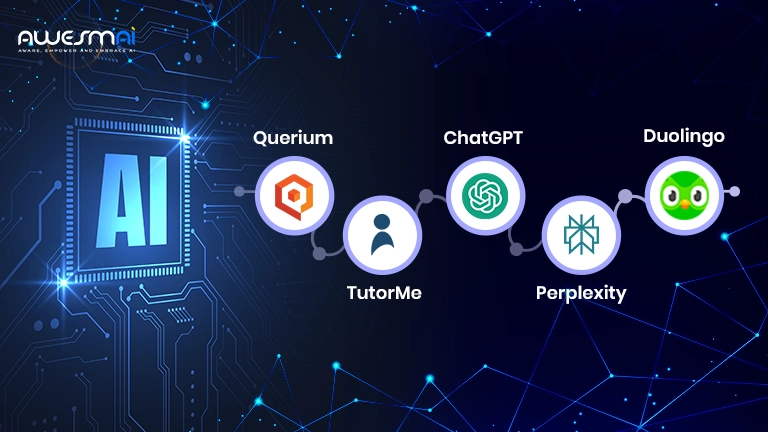
If you are someone who is planning to make the learning experience more efficient by using artificial intelligence, knowing some of the best AI-based education tools can be a great idea. Whether it streamlines the business management processes or takes AI assistance to learn new things, there are AI tools that you can rely on. Let’s have a glance at the top 5 AI-based tools in the education industry-
1. Querium
This is a popular tool that helps to implement AI use in education by elevating the overall learning experience of the students. This tool uses machine learning capabilities to assess the strengths and weaknesses of students. By gaining real time information about learners’ performance, it can provide personalized instruction and feedback to implement the necessary changes that can help to better achieve the goals.
Key Features
- Helps students solve math problems step-by-step
- Personalized learning experience by adapting to the student’s learning style
- Immediate feedback on the solutions with real-time correction
- Hundreds of inbuilt unique problem variants to develop critical thinking skills
- 24*7 access to personal AI tutor
2. TutorMe
TutorMe is a great example of AI implementation in the education sector. This innovative tool is designed to connect the learners to the right tutors in a remote environment. The solution relies on the use of artificial intelligence to assess the real-time requirements of the students and thus connects them to the best tutors according to their schedules, budget, and expertise. At the same time, TutorMe also helps to provide timely feedbacks and support to its users, ensuring a seamless learning journey.
Key Features
- Real-time audio/video conferencing between students and tutors
- Interactive whiteboards that encourage collaboration
- Flexible scheduling according to the learner’s convenience
- Access to additional resources like video tutorials and downloadable worksheets
- A user-friendly interface that makes features more accessible
3. ChatGPT
Irrespective of the industry, ChatGPT remains the top AI application. Even in the education industry, ChatGPT is highly used by the students, tutors, and management professionals for its capability to analyze problems and provide solutions. For example, the teachers can the institution management can allocate the resources more efficiently by taking suggestions from this tool. At the same time, the assessment tasks can be streamlined for teachers using this innovative tool. Students can use ChatGPT to collect information about their assignment without scrolling through hundreds of web pages.
Key Features
- Immediate feedback by uploading the assessments and homework
- Research and writing assistance to save time and effort
- Interactive learning activities like quizzes and simulations
- The virtual tutor feature that provides personalized instructions
- Generate a different level questionnaire that enhances problem-solving skills
4. Perplexity
This is another AI tool that is highly preferred by research scholars. The RAG (Retrieval Augmented Generation) technology integrated in this tool is so powerful that it can collect insightful information from numerous sources within seconds. At the same time, it also quotes the original sources under each sentence, which makes it very easy for the students to create notes and get updates about new incidents. Perplexity even allows users to create PDF files for easy sharing and storing notes.
Key Features
- Up-to-date information about topics and subjects
- Clear and concise answers for better understanding
- Transparent source citation for assignment purposes
- Content summarization to get highlighted notes
- Multimodal support that analyzes even images and codes
5. Duolingo
This is a well-known language learning platform that has helped millions of users to learn new languages. Duolingo has recently added machine learning capabilities to its features that offers personalized lessons, track progress, provide real-time feedback, and make the language learning process more enjoyable for the learners. At the same time, it aligns with the learning pace of the students, which enhances the overall user experience.
Key Features
- Streaks feature that encourages daily practice sessions
- Self-paced learning that adapts to the user’s learning style
- An extensive goal-setting feature that helps to track learners’ performance and make improvements to achieve goals
- Audio and visual options to enhance the learning experience
- Interactive exercises to learn language from real-world scenarios
Future of AI in education
AI trends in education are continuously evolving, and there are a lot of transformations that we are going to witness in the near future. Whether it is shifting towards a more personalized learning experience or a scenario where AI can make education more accessible to people living in remote or underprivileged areas, the future is going to be constructure. Here are some of the wonderful changes that we might witness in the future with AI use cases in education.
1. AR/VR For Real-Time Learning
Augmented reality and virtual reality are becoming popular every day due to their capability to bring 2-D images into the 3-D world. Observing the current transformation pace, it is not very long before we will be witnessing the use of AR/VR by history teachers to explore historic monuments in classes, science tutors to teach about the universe, biological professors to give insights into the living body, and much more.
2. Advanced Distance Learning
Despite the huge technological advancements, distance learning can not compete with the efficiency of offline classes in the current landscape. However, this gap is expected to vanish with the use of AI in distance learning. Artificial intelligence can play a significant role in establishing a close connection between the tutors and remote learners, fostering immediate assistance and intelligent tutoring.
3. Customized Courses
We all have witnessed the pre-curated courses on different topics and skills. However, there are no options to change the content or intent according to our personalized needs. But thee are huge chances that we can witness the customized courses very soon. AI can make alterations in courses so that they can better align with our goals, interests, and preferences.
4. Increased Accessibility
The students planning to study abroad face a big challenge of language differences. The only option left for them is to learn the new language or drop the idea. However, the use of AI in education might change the scenario. The installation of AI tools with the capabilities of natural language processing might eradicate the need for students or tutors to learn a new language. The real-time translation of speech by AI might do all the work.
Conclusion
The use of AI in education is something that might drive a big societal transformation very soon. The reason behind the statement is that AI use cases in education change the way students perceive the information and learn to implement them uniquely. For example, understanding the concept rather than just cramming it will play a big role in driving innovation across the nations. At the same time, AI in the education system eliminates the need to spend days creating notes and thus offers more time to learners and tutors to explore new topics and gain profound knowledge. Technologies like AI, AR/VR, machine learning, natural language processing, and large language models are reshaping the education standards and might redefine the way we think of education in the current era.
Frequently Asked Questions (FAQs)
What is AI in the education sector?
Answer- AI in education simply refers to the implementation of AI applications in the education sector that brings advancement, efficiency, and innovation in the overall industry. It talks about the use of AI for personalized learning, better performance monitoring, optimized scheduling, interactive learning, and much more.
How does AI help students in education?
Answer- AI helps the students in numerous ways. For example, it fosters personalized learning that makes education more engaging and fun for the students. Moving ahead, it provides more accessibility to study sources and tutors, saves time by automating tasks like note copying, and even helps in identifying the student’s interest areas to develop future skills.
What are the different AI use cases in education?
Answer- There are hundreds of AI use cases in education that can transform the way students engage in their studies. Here are the main AI use cases in education-
- Instant content generation
- Task automation
- Better access to education
- Round-the-clock tutor assistance
- Customized information according to student needs
- Better understanding of skill gaps and making corrections
- Effective curriculum planning
- Instant feedback and assessments
- AR/VR learning
- Language learning
What is the role of Generative AI in education?
Answer- Generative AI is a specific part of artificial intelligence that exclusively helps in generating different types of content in multiple formats like texts, images, videos, and even code. Thus, generative AI can be used by the students for self-study. For example, generative AI tools can be a great option for quizzes, where they can help to assess the knowledge about a particular topic by asking questions. Similarly, generative AI can help the student to identify the key highlights of their notes to focus more on the important areas of the chapters.
How does AI personalize the learning experience for students?
Answer- AI focuses on analyzing the student’s data and performance throughout the year. It helps to identify the strengths and weaknesses of the students. Thus, it becomes easier to curate personalized learning plans that align with real-time goals, focus on eliminating weaknesses, and match the learning pace of the student. At the same time, it can also help to identify the interest of students in the particular subjects and thus even play a significant role in giving the right direction in their higher education and professional journey.
What are the main benefits of AI in the education sector?
Answer- There are numerous benefits of AI in the education sector, which include-
- Personalized learning
- Intelligent tutoring systems
- Automated grading and feedback
- Data-driven decision making
- Improved accessibility to education
- Easy language acquisition
- Better student engagement
- Increased administration efficiency
- Active feedback and assessment



